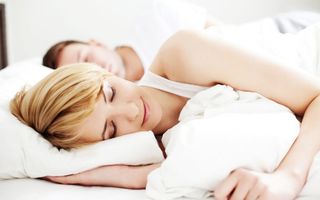Sleep
New Findings on Sleep Apnea in Women
Debunking the myths surrounding sleep apnea
Posted June 26, 2019

Real quick: What image comes to mind when I ask you to picture a “typical” sleep apnea patient? Chances are, you imagined someone overweight, sedentary, middle-aged... and male.
We’ve made some real progress in changing this stereotype. But obstructive sleep apnea is still too often thought of as primarily a men’s health problem. It’s a problem for women’s health because the reality is, women face real risks for sleep apnea.
In my practice, I’m currently treating about a third as many women as men with sleep apnea. Not all of them are overweight. While more of them are in menopause than not, a number of my female OSA patients are younger women, under age 50, and a couple are currently pregnant. All of them are active, health-conscious, busy women who work hard to take care of themselves. How’s that for stereotype-busting?
When it comes to OSA, women often experience symptoms differently than men do. That distinct symptomatology, along with the persistent, misguided sleep apnea stereotypes, results in the great majority of women with OSA going undiagnosed—or misdiagnosed with another condition.
As science increasingly turns its attention to the gender differences in sleep apnea, we’re also learning that women may face particular risks to their long-term health from this form of sleep-disordered breathing.
With this in mind, let’s take a look at the real story of how women experience sleep apnea, and what the latest science tells us about the health risks it poses—and the treatments that women benefit women the most.
How common is sleep apnea in women?
The answer to this question has changed significantly in recent years, as we’ve learned more about how sleep apnea presents in women. But I’m not convinced we have a handle on just how common sleep apnea is for women. While earlier studies indicated that men were as much as 9 times as likely to have sleep apnea as women, today we know that sleep apnea in women is common, and the gap between men and women is nowhere near that large. Current estimates suggest that men may be 2 or 3 times as likely to experience sleep apnea as women—but that gaps close as women age and enter menopause, and can become a 1:1 ratio. And because screening and diagnosis is still so poor among women, a lot of today’s estimates are still likely to be low
A recent population-based study found that an estimated 6 percent of women of all ages have moderate or severe sleep apnea and an additional 5 percent of women have a mild form of OSA. (For men, those numbers were 13 percent with moderate to severe OSA, and an additional 14 percent with mild sleep apnea.) By the age of menopause, 20 percent or more of women may develop sleep apnea, according to this research.
This study also found major increases in the prevalence of sleep apnea among women and men over the past two decades—with the largest jumps among younger women and younger men.
Another recent study found evidence of sleep apnea in 50 percent of women in a population-based sample of 400 women between the ages 20-70. Among this group, severe sleep apnea was present in 14 percent of women ages 55-70 and in 30 percent of women in the 55-70 age group who had a BMI (body mass index) of 30 or higher.
Research indicates that approximately 1 in 4 women in the United States is at high risk for sleep apnea.
One of the most important stats regarding women and sleep apnea? An estimated 90 percent of women with this sleep-disordered breathing disorder are living with it undiagnosed.
OSA symptoms and risk factors for women
The classic symptoms of sleep apnea we hear about most often are:
- Snoring that is loud and frequent
- Gasping, choking, snorting sounds during sleep
- Observable episodes of lapses in breathing (by partners)
- Need to urinate often during the night
- Headaches, dry mouth, and sore throat in the morning
- Trouble concentrating during the day
- Excessive daytime sleepiness
Women may experience some or all of these symptoms. Studies suggest that among women at high risk for sleep apnea, chronic snoring and significant daytime sleepiness are common symptoms.
But not all women with OSA will display these symptoms. For example, it’s entirely possible to have OSA without loud and frequent snoring, or without observable episodes of interrupted breathing. And women with sleep apnea may have other symptoms that they—and their doctors—are less likely to connect to this sleep disorder. These include:
- Insomnia symptoms, including trouble falling asleep and difficulty staying asleep
- Restless sleep with frequent awakenings (even if you don’t need to use the bathroom)
- Symptoms of Restless Leg Syndrome, including the uncomfortable tingling in legs when sitting or resting in the evening
- Changes to dreaming
- Heartburn at night
- Feeling irritable during the day
- Feeling regularly overwhelmed
- Feeling anxious or depressed
- A lack of energy, even after a full night of sleep
- Forgetfulness
- A tendency to be accident prone
Any of these symptoms are worth a conversation with your doctor—one that specifically raises the topic of sleep apnea and a sleep apnea screening.
As with men, women who are overweight or obese are at greater risk for sleep apnea. (In fact, there’s some evidence suggesting that excess weight may play an even greater role in women’s risk for sleep apnea than in men’s risk.) Smoking, having a family member with sleep apnea, and age are other major risk factors that men and women share.
Women also have specific risk factors for sleep apnea that aren’t well enough known, to women themselves or to their physicians.
Polycystic Ovary Syndrome (PCOS). Studies show that women with this very common endocrine disorder are at greater risk for sleep apnea. Both OSA and PCOS are themselves linked to obesity. But the link between OSA and PCOS doesn’t appear to come through being overweight. A 2019 study has shown that women with PCOS are more than twice as likely to develop sleep apnea, independent of obesity.
Pregnancy. Most of us don’t associate pregnancy with sleep apnea. But women who are pregnant may be at elevated risk for developing OSA, likely as a result of changes to sleep patterns, weight gain, and changes to women’s anatomy that affect breathing. Recent research shows that pregnant women with OSA are more likely to develop high blood pressure in pregnancy and gestational diabetes. Pregnant women with sleep apnea are also much more likely to have pregnancy complications that require treatment in a hospital’s intensive care.
Menopause. A woman’s risk for sleep apnea goes up dramatically as she enters menopause. Before age 50, OSA appears to occur in men roughly 2 to 3 times as often as in women, according to today’s research estimates. As women age, that gap decreases substantially. Why? The hormones estrogen and progesterone appear to have protective effects over women’s sleep and their breathing during sleep. As those hormones decline in menopause, the risk for sleep-disordered breathing including OSA goes up. This 2017 study found that menopause-related reductions in estrogen are linked to an increased risk of OSA in women.
Other recent research indicates that from perimenopause onward, a woman’s risk for sleep apnea increases by 4 percent each year.
(I’ve written about the complex effects that menopause has on women’s sleep and sleep-related health, and steps women can take to protect their sleep during menopause, including using natural supplements.)
Because signs of sleep apnea in women may be more subtle than in men and don’t always conform to that classic list of symptoms, women with OSA have a real risk of having their sleep condition go undiagnosed. Physicians aren’t always as attuned to the risks of sleep apnea in women as in men, and that also contributes to the estimated 9 of 10 cases of women’s sleep apnea that currently go undiagnosed.
Some of the most common symptoms of sleep apnea in women, including weight gain, low energy and persistent fatigue, anxiety and low mood, stress and a sense of being overwhelmed, are also symptoms of many other health issues. Women with OSA may have their sleep apnea symptoms attributed to:
- Depression
- Anxiety
- Thyroid conditions, including hypothyroidism
- Fibromyalgia
- Insomnia
- Prediabetes/diabetes
- Obesity
- High blood pressure
- Menopause
Sleep apnea in women often occurs alongside these conditions—and in several cases, sleep apnea may contribute to the development of these health problems. But often, sleep apnea goes overlooked and undiagnosed. In some cases, this may result in overtreatment of other conditions, or treatment that’s ineffective—because the actual underlying issue is sleep apnea. I recommend that women who’ve been diagnosed with any of these conditions talk with their doctors about a sleep apnea screening.
What are the sleep apnea health risks for women?
Left untreated, OSA contributes to several serious health risks, including heart disease, high blood pressure, stroke, weight gain and diabetes, and depression. Having sleep apnea that isn’t being treated significantly increases the risk for accidents. It also leads to problems with cognitive function, including issues with memory, attention, and learning. Research—including a soon-to-be-released study from sleep scientists at the Mayo Clinic—indicates that people with sleep apnea may accumulate higher concentrations of a brain protein that’s involved in the development of Alzheimer’s disease.
These are serious risks that apply to men and to women. As scientists look more closely at gender differences associated with OSA, we’re learning more about the particular health risks that women face. Here’s what some of the very latest scientific research tells us.
Heart disease. Several recent studies show that women may be more vulnerable than men to some cardiovascular problems that arise from sleep apnea. A 2018 study in the UK found that snoring and sleep apnea may impair women’s heart function more easily and more severely than men’s, putting women at greater risk for heart problems. These results align with earlier research, including a 2015 study that found OSA in women connected to more significant heart damage, as well as a greater risk for heart enlargement, coronary artery disease, and heart failure.
This 2013 study by scientists at UCLA found that both men and women with OSA tend to have less effective control over blood pressure and heart rate than people without sleep apnea. The study found that these controls—known as autonomic responses—may be more compromised in women than in men, leading women to be more at risk for hard-to-treat high blood pressure and other cardiovascular issues.
Research suggests women may be more likely to experiences episodes of apnea during REM sleep. A new study released in 2018 has found that REM-based sleep apnea episodes in women are associated with atherosclerosis, a thickening of the artery walls that is a major cause of heart attack and stroke.
Depression. There is a major overlap between sleep apnea and depression, in both men and women. In one recent study, more than 50 percent of patients with depression had severe sleep apnea. There are some indications—including a study from 2017—that women may experience depression in connection with sleep apnea more often, and more severely, than men.
Obesity and exercise. Obesity is a prime risk factor for sleep apnea in both men and women. And OSA, in turn, can contribute to weight gain and obesity risk. One way that sleep apnea may increase obesity and other health risks in women? By limiting women’s ability to exercise. In a recent study, researchers in Brazil examined the relationship between OSA, obesity and exercise in a group of more than 200 women aged 45-65. Scientists found 39 percent of the women had sleep apnea, and 33 percent were obese. Women who had both OSA and obesity had significantly less capacity for exercise than women with only one condition or neither.
Sleep apnea diagnosis and treatment for women
I encourage all women to start ongoing conversations with their doctors about their sleep, and specifically about their risks for sleep apnea. Bring to your doctor’s attention changes to your sleep, your mood, your cognitive performance, as well as your energy levels. Women with any of the symptoms and conditions I’ve discussed above should talk with their doctors specifically about a sleep apnea screening. I also recommend that women in perimenopause and menopause discuss sleep apnea screening with their physicians, even in the absence of any symptoms.
How is sleep apnea diagnosed?
It’s pretty common these days for doctors to prescribe home sleep tests that diagnose sleep apnea. For many women, this is a terrific option that saves them a night in a sleep laboratory. However, these home sleep tests do not catch every case of sleep apnea. Studies suggest that they deliver “false negative” results in 10-20 percent of cases. For women at high risk for OSA, I recommend that a negative result on a home test be followed by a sleep laboratory test for sleep apnea. The inconvenience of a single night in a sleep lab is a small price to pay for the benefits of catching and treating this sleep disorder.
How is sleep apnea treated?
CPAP, or continuous positive airway pressure therapy, is the most common treatment for moderate and severe sleep apnea. I hear from many of my women patients that they’re reluctant to use CPAP. At the same time, every woman patient I treat who does use their CPAP regularly is experiencing significant improvement to their apnea and their sleep and is lowering their risk for other serious health problems. The bottom line? CPAP works. New research indicates that women are more likely to stick with using CPAP regularly (and get the maximum benefit) when they have strong support from their partners. If you’re a woman with OSA who’s been prescribed CPAP, talk to your partner and the people close to you, to rally support. If you have a woman in your life who needs CPAP to treat OSA, be her ally in this process.
Some good recent news about CPAP treatment in women? In addition to relieving symptoms of the disorder, CPAP use also can lead to a big jump in sexual satisfaction and quality of life for women.
CPAP isn’t the only treatment available for men and women with sleep apnea. Oral appliances are now considered a first-line treatment for mild and moderate sleep apnea, and for severe sleep apnea in people who can’t tolerate CPAP. There are many different types of oral appliances available to treat sleep apnea. You’ll work with your physician and a dentist to determine the right one for you, to have the device custom made and fit, and to make sure it’s working to relieve your OSA symptoms. New research indicates that some oral appliances may work more effectively in women with OSA than in men.
Losing weight is another way women (and men) can help to improve sleep apnea. Weight loss won’t necessarily take care of sleep apnea on its own for every woman. But weight loss can make a big difference and reduce, if not eliminate, the need for other OSA therapy.
Sweet Dreams,
Michael J. Breus, PhD, DABSM




